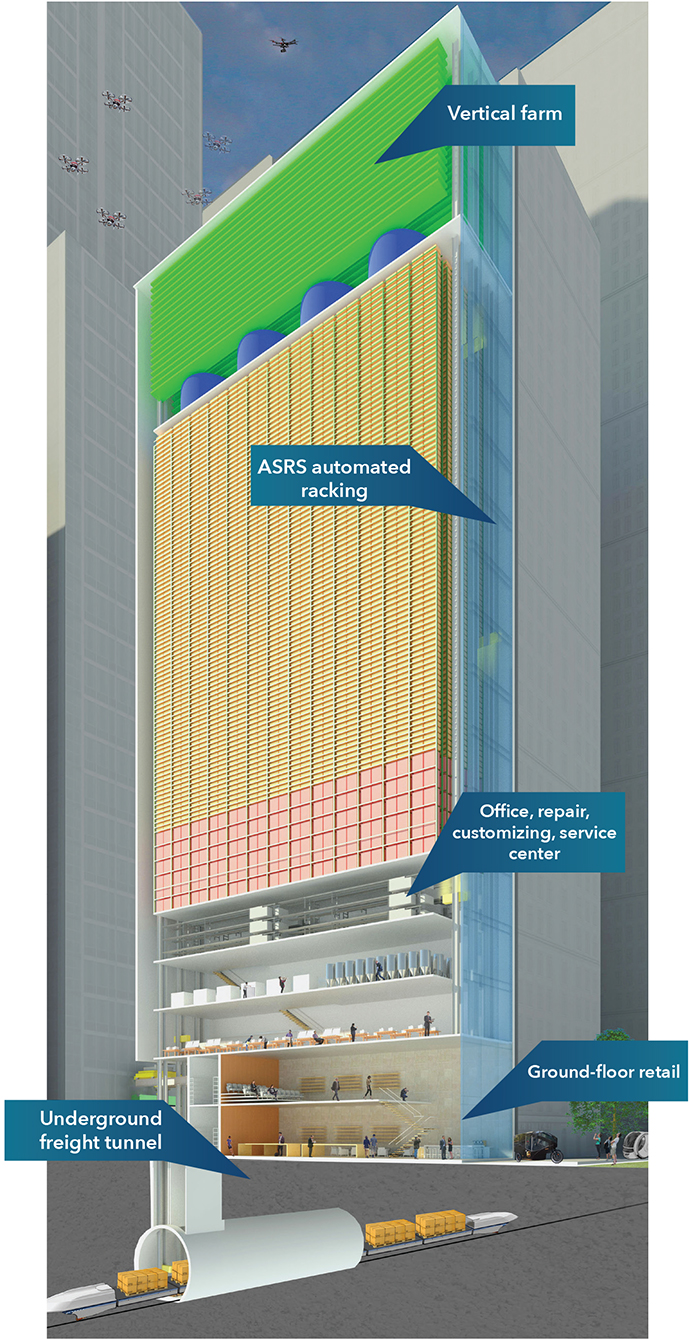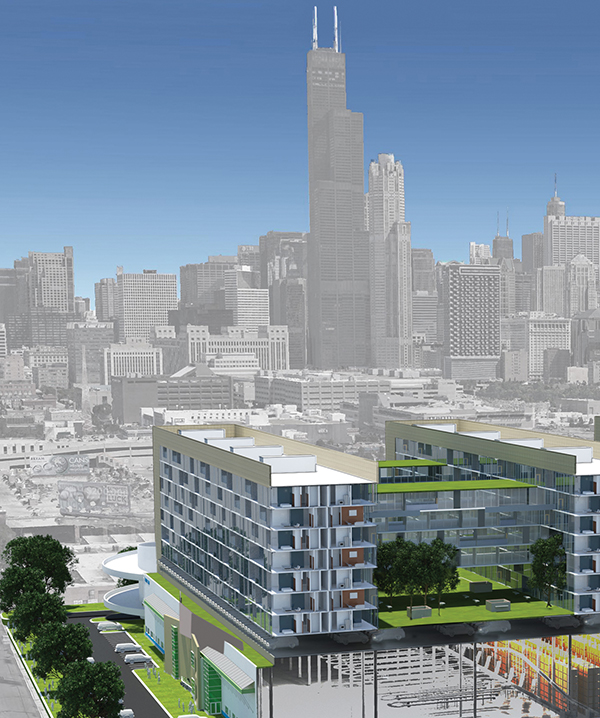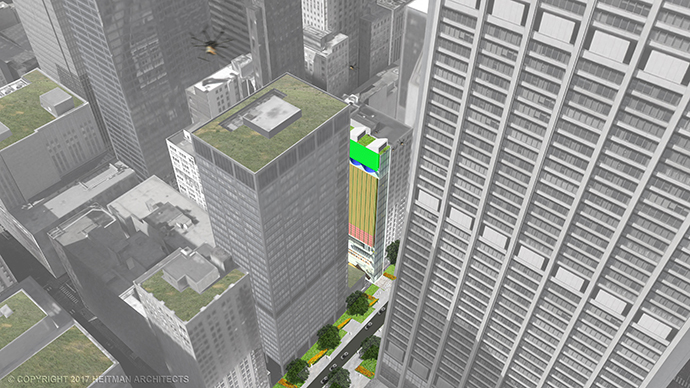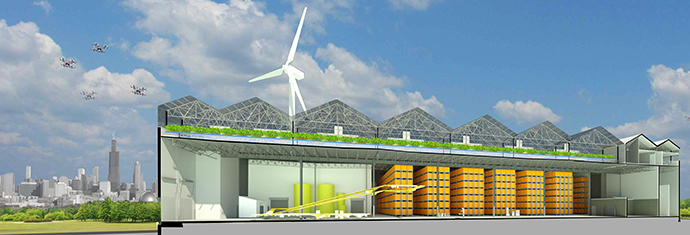What do I do with obsolete and increasingly unviable warehouse space? What is the future of distribution? What kind of future-proof distribution system will strike the balance between cost-effectiveness and growing demand for just-in-time delivery? These are the considerations behind the third in a series of reports commissioned by IAMC and SIOR with funding from the SIOR Foundation as part of the associations’ DesignFlex2030 initiative. Previous reports included "Recipe for Change," addressing food processing, and "Rx for Change," addressing biopharmaceuticals.
"Roadmap for Change" explores new design approaches that could lead to more flexible, adaptable and sustainable industrial facilities in the future. (Click here for the full version of the report.)
"The keys to the kingdom in this new distribution world are global data, connectivity, redundant power and efficient human-machine interfaces," says Andy Cannon, director of business consulting at Ghafari Associates, the lead engineering firm on the project; Heitman Architects was the lead architectural firm. "If any of this falls apart, the entire distribution network fails. At the end of the day, this all becomes a highly sophisticated data-management exercise."
The DesignFlex2030 team defines the new network as a connected web of multiple fixed and mobile facilities, varying in size, shape, function and scope, strategically located at various points along the logistics journey between OEM and end users in a 24-7 network. It transforms overlooked and underutilized space — along with the air above and ground below — into a new industrial real estate resource that can be deployed for multiple uses.
DISRUPTOR: ROBOTICS AND AUTOMATION
will do
- Alter assembly lines
- Automate dangerous, repetitive, tedious tasks
- Fill labor gaps
- Increase productivity, quality, and speed with 24-hour, lights-out operation
- Enable efficient last-meter delivery in traffic-congested communities
- Decrease "single points of failure"
- Provide seamless transfer of data and information
- Enable real-time analysis for improved decision-making
warehouse design
- Lights-out warehousing
- Increased shipment weight
- Fewer corridors for walking
- Fewer restrooms
- More charging stations
- Smoother floors
- Rooftop communications systems
- Scalability
- Indoor temperature differential
- Insulation from elements
- Self-generated back-up power
- New inventory storage patterns and flow of goods
- High density
- Sensors, scanners and readers
- Electronic monitoring center
accommodate change
- Mini-automated DCs Smaller footprint
- High ceiling heights
- Vertical construction
- Warehousing as part of a mix of uses
- Leverage existing space to accommodate fulfillment and returns
- Investments in next-gen fiber optics, digital photonics, and alternative energy
The first part of the white paper analyzes such trends as megacities; just-in-time delivery, particularly along the "last mile"; growing urban populations; inventory flow vs. inventory stock; disruptors, such as the sensor-driven Internet of Things; and e-commerce centers opening nearly as fast as retail stores are closing. The second part, adapted here, addresses what those new facilities of the future might look like, where they might be located and why.
Reimagined Distribution Centers: Today’s Warehouse Is Tomorrow’s Factory
These facilities are imagined as flexible retrofits of aging and obsolete warehouses. They are a practical response to the rapid shift in supply-chain dynamics due to digital connectivity and new consumer demands, requiring a shift from eight-hour, five-day-a-week operating shifts to 24/7, lights-out automation. Today’s distribution centers become tomorrow’s factories.

Modular, fully contained units can slide in and slide out to enable continuous upgrades as technology advances and needs change. The modular approach also allows the facility to accommodate different industrial needs at the same time. Powered by renewable energy sources, these new factories of the future will produce a variety of custom products upon order, using additive manufacturing technologies. Finished-goods inventory gets replaced with raw-ingredient supply storage. Parts are digitally produced on site with automated, on-demand final assembly. Special components are shipped from regional suppliers on freight rail.
The concept represents a strategic opportunity for companies that are part of the same supply chain to co-locate, thereby significantly lowering their logistics costs and shrinking their delivery time frames. Meanwhile, larger-scale industrial products — bulk chemicals, massive steel beams, "white goods" such as refrigerators — could be stored easily for conventional transport to the next point along their logistics journey.
Located between five and 15 miles from city center, these facilities become community supply hubs, connected to a network of mobile fulfillment vehicles. Multiple access points enable the range of supply and delivery modes, including sensor-embedded truck bays for docking of autonomous and semi-autonomous carriers.
The facilities have the capacity to handle operations for three independent companies, working collaboratively under a single roof. It creates the potential to consolidate a supply chain spread across a 1,500-mile radius into a single facility, thereby significantly reducing logistics costs and time frame.
Housing More Than Goods
The design team deployed similar adaptive reuse concepts when considering the potential in obsolete corporate campuses, shopping malls, or blighted industrial land. They identified a way to create vibrant new transit-oriented developments in emerging fringe neighborhoods outside city centers, while accommodating manufacturers’ and third-party logistics providers’ needs for more close-in industrial space. Designed for a population striving for better work-life balance, the new, 20-acre, live-work-play development includes an industrial component, tucked beneath high-end housing for next-generation urban dwellers.
INDUSTRIAL BASE OF MIXED-USE DEVELOPMENT
- 400,000 sf with 40-foot clear height
- Flexible 60-foot-by-50-foot bays
- Mix of industrial uses: three-level pick modules, ASRS systems, VNA and wide-aisle racking, additive manufacturing printer farms, repair
- Ability to convert to pop-up food hall, retail, or holiday mart
- Door openings to accommodate self-contained modules
- AGV support: inspection/charging
- 180-foot-deep service courts enabling cross-dock operations
- Underground freight rail/hyperloop connections to urban core for high-speed delivery to urban core
- 87 full-size semi-tractor trailer smart docks for semi-autonomous truck/self-driving trailers, with 4 drive-in ramps
- Gantry cranes to transfer trailers to and from freight tunnel
- Micro-depot and AGV support hub
- On-site storage for up to 85 53-foot trailers
- On-grade parking/landing pad/docking for up to 375 autonomous industrial vehicles
"This is a perfect solution to the dilemma faced by many companies that want to locate warehouses closer to their customers," says Karl Heitman, DesignFlex2030 team co-lead and president of Heitman Architects. "The closer into urban areas you get, the more expensive the land becomes. This is a way to afford the land you need for your distribution and warehousing in places where land costs are high."
Here, the residential component covers the cost of development. It creates a new financial rationale that alters the old commercial real estate conventional wisdom about not using higher value land for lower value purposes.
"Housing is the important financial driver here," says Ghafari’s Andy Cannon. "The idea is that you could take a large footprint of very valuable land, on which you develop residential, retail, and commercial, and which ends up paying for itself. You slide in the distribution component on the bottom level, basically giving you these industrial uses for free."
The design concept makes good financial sense in other scenarios as well: An assemblage of abandoned, obsolete properties at the city edge is catalyst for revitalization of blighted, low-density industrial sectors.
Warehouse Capabilities
The 400,000-sq.-ft. footprint accommodates 40-foot-clear flexible production space. Additive manufacturing, three-level pick modules, and Very Narrow Aisle (VNA) storage and retrieval systems operate invisibly under the virtual city above. An open configuration enables rapid change-out of uses: from warehouse to autonomous retail shop-on-wheels that slides into the same space as a pop-up bricks-and-mortar store, controlled via wireless mobile applications.

As new transportation infrastructure comes on line, the complex has the capability to accommodate new underground and in-the-air traffic patterns. Mechanisms are in place to move trailers to and from underground freight tunnels. Pedestrian accessways link residents to their city center commutes via hyperloop. The apartment blocks sit above green decks that feature convenience retail shops, parks, playgrounds and ball fields. A parking deck separates residential uses from clean industrial uses below.
With lot-line-to-lot-line vertical construction and a building envelope that soars 40 stories but blends into the fabric of the cityscape, these facilities are built on small, vacant, and hard-to-develop parcels throughout the megacities. They meet the small-scale fulfillment requirements of the local residential and commercial population. They also can accommodate a range of other uses.
Goods could be supplied via maglev skyway train or an underground pneumatic tube system that is connected to urban freight tunnels. Self-driving or semi-autonomous trailers also deliver through alleyways. They are lifted via gantry crane to upper floors for unloading. The 2,950-sq.-ft. footprint replaces a 135,000-sq.-ft., traditional suburban distribution center based on volume capacity. Of note: It increases operational productivity by 75 percent, due to embedded efficiencies.
The street-facing building side is the only one visible. A transparent glass exterior allows views into the elegant machinery at work inside. Lit up by a colorful and changeable array of LED lights, the facility itself becomes a breathtaking piece of performance art.

The idea, says Karl Heitman, is to flip today’s standard horizontal design on its ear, and in the process take the proverbial sow’s ear — an unattractive warehouse — into a silk purse. "The warehouse of today is really long and really thin," he says. "If you tip the whole thing on its side, you could fit 1 million square feet of horizontal warehouse into this really tall but really narrow vertical space as the perfect urban configuration."
Eliminating the Traditional Notion of Inventory
In this scenario, traditional inventory gets eliminated. Raw materials and product components are replenished by autonomous freight trains from the freight tunnel network below the streets. Drive-through receiving and shipping functions are handled by vertical-lift gantry cranes on one-way back alleys. The 40 floors of the building are designed to enable flexibility.
Ground floors are pedestrian-oriented experience centers for shopping along streets converted to green, carless parkways within the central business district. The retail experience center offers virtual reality opportunities to further customize products in progress. It also serves as a recycle center, where obsolete products are returned, disassembled, and then recycled into new products on upper floors.
“There will be a fair amount of disruption in the spare parts supply chain as additive manufacturing technologies get perfected.”
Middle floors house additive manufacturing modules and final product assembly to produce custom, order-of-one products in real time. The system feeds last-meter delivery to urban consumers within hours of order placement. Upper floors serve as a warehouse with three aisles of vertical automated storage and retrieval system (ASRS) for parts sub-assembly components and raw materials that supply manufacturing below.
Three top floors feature a multi-level aquaponic conveyer system that produces 500 tons of fresh produce annually. Rooftop real estate accommodates tilapia fish tanks that generate the nitrates needed for growing. The fish tanks serve another important purpose: as dynamic stabilizers to minimize the sway of the high-rise.
Solving the Last Meter Delivery Dilemma
Already, the reality of getting goods directly into the hands of city dwellers is creating logistical headaches. "That last mile — including the last meter — is one of the most costly and complex steps in the supply chain," says Matthias Winkenbach, director of MIT’s Megacity Logistics Lab.
The network of the future addresses the issue head-on, as the proposed hyperlocal center becomes a new supply-chain node on a physical Internet distribution model. It replaces bricks-and-mortar facilities with a real-time, on-demand, Uber-like mobile delivery hierarchy. Roving autonomous "mother ship" trucks supply fleets of autonomous vans that circulate the city on 24/7, continuous routes. The vans carry goods along with a contingent of drones and robotic carts for last-meter/rooftop and doorman deliveries.
With alleyway access and underground docking berths at the hyperlocal center, the motherships are lifted by internal gantry crane for automated replenishment, guided by artificial intelligence that identifies restocking needs through sophisticated, lightning-fast algorithms.

Air Rights: The New Warehouse Development Frontier
Third-party logistics providers like are already eyeing land in densely populated areas for industrial warehouse development. But with demand growing and limited availability of large, industrial-zoned parcels in desirable locations, designers of warehouse space are beginning to look upward rather than outward.
By the Numbers:
Opportunities to Repurpose U.S. Real Estate
17%
VACANT LAND
ACROSS LARGE CITIES
4%
OF CITY
ADDRESSES VACANT
NEARLY 1 TRILLION SQ. FT. OF OBSOLETE SUBURBAN
OFFICE SPACE
25%
OF U.S. SHOPPING
MALLS SLATED TO CLOSE
WITHIN NEXT 5 YEARS
5.3%
INDUSTRIAL VACANCY
RATE — A 17-YEAR LOW
In April 2017, ProLogis broke ground on the first such facility in its own portfolio — a three-story, 589,615-sq.-ft. fulfillment center in South Seattle, Washington. The project, Georgetown Crossroads, is a first-of-a-kind in the United States — a highly visible, Class A facility featuring ramps for truck access to second-floor loading docks. A freight elevator will link the third floor to ground-floor loading docks. The company reports that the new paradigm was necessary because consumer are increasingly coming to expect rapid delivery of online orders, and transportation costs are rising.
This example brings into focus the challenge for developers, owners and users of warehouse space. Now, more than ever, land in densely populated areas is being eyed for industrial warehouse development. Repurposing narrow slivers of hard-to-develop urban land into multiple vertical, hyperlocal warehouses as proposed by the DesignFlex team could open up a world of options, even as removing stubborn little pockets of urban blight represents a real win for cities.
Areas for Future Study
As the team moved forward with its work and identified the full array of disruptions taking place, it became clear that some related issues requiring exploration fell outside the scope of this paper. Further exploration is recommended on the following:
- Zoning codes: Changes to accommodate flexibility as uses change
- Identification of future warehouse needs: Will the need for the mega-warehouse disappear entirely? Will there be a shift toward holding more properties, each with smaller footprints?
- Incentives to encourage redevelopment of remnant parcels and obsolete office space
- Approaches to strengthen fiber-optic networks
- Energy investments to enable power redundancy
- Demographic trends as the millennial generation ages: If the urban trend reverses itself, can the distribution network accommodate the shift?
- Transformational strategies to create smart, connected cities
- Financing next-generation transportation infrastructure.
